Two Fuels Power Chevrolet’s Full-Size sedan
“Alternative fuel” usually means electricity, biofuels like ethanol or renewable diesel or even (erroneously) gasoline-powered hybrid-electric vehicles. However, one plentiful, inexpensive and clean fuel is underutilized—compressed natural gas or CNG. Honda produced a Civic powered by CNG starting in 1998, but dropped it last year. So, if you are looking for this technology in a passenger car, the 2016 Chevrolet Impala Bi-Fuel is for you. Chevrolet produces the only sedan in North America to run on unleaded gasoline and compressed natural gas, continuing what Chevrolet says, “demonstrates their commitment and leadership in energy diversity.”
Natural gas is the cleanest burning of all fossil fuels on a lifecycle basis according to the U.S. Department of Energy, and it is abundant. With recent advances in hydraulic fracturing technologies—
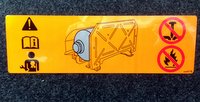
more commonly known as fracking—and advances in capturing methane gas from landfills and other biogas sources, the natural gas supply is solid for decades to come according to industry estimates. Its cost per an equivalent gallon of gasoline (GGE) runs 30–40 percent less than gas or diesel, and a CNG-fueled internal combustion engine will have a longer service life and require less maintenance because natural gas burns so cleanly, producing almost no combustion by-products in the motor oil, spark plugs or injectors.
The 2016 Chevrolet Impala Bi-Fuel we were driving looks exactly like the gasoline powered Impala except for the federally mandated (for emergency responder’s safety) blue and white diamond-shaped CNG sticker on the trunk lid.
Drivetrain
The front-wheel drive, six-speed automatic Impala Bi-Fuel is powered by a DOHC 3.6L V6 with variable valve timing. The horsepower and torque depend on which fuel is being used: gasoline puts out 260 hp and 247 lb-ft of torque while CNG delivers 230 hp and 218 lb-ft of torque. Without going into performance numbers, that 30 hp and 29 lb-ft of torque can make a big difference when it is time to get up and go. But in the case of the Impala Bi-fuel, the reduced CNG numbers were not an issue as the oompf under both fuels was more than adequate for all types of driving conditions. The Impala is available with two other gasoline-only engines, a 2.5L inline four-cylinder putting out 196 hp and 186 lb-ft of torque while the 3.6L V6 hits those numbers at 305 and 264.
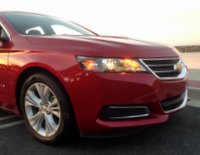
Chevrolet says, that according to federal Environmental Protection Agency estimates, the 2016 Impala Bi-fuel has a natural gas range of 119 miles and a gasoline range of 368 miles for a total range of 487 miles. Chevrolet estimates the natural gas range to be about 150 miles of city driving and to hit 500 city miles combined. Interesting variables that usually do not come into play when refueling with gasoline or diesel is that the actual driving range can vary based upon ambient temperature and current pressure available at the CNG refueling station.
The Impala Bi-fuel primarily runs on CNG and, when the tank is depleted, it switches to gasoline. However, there is a button on the dash where either fuel can be selected and used as the driver chooses. Since a car is least efficient in city driving with multiple stops and starts, I opted for the less expensive CNG and then went to gasoline mode for highway driving.
Driving Impressions: On the Road
The Impala LT Bi-Fuel comes with 18-inch lightweight aluminum-alloy wheels, all-season tires, electric variable-effort power steering, power-assisted front disc and drum rear ABS brakes,
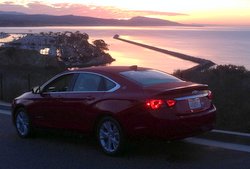
MacPherson independent strut front and multi-link rear suspension with stabilizer bars at both ends. As expected of any car that weighs 4,175 lbs., the Impala Bi-fuel is smooth on the highway and pretty much obliterates all road irregularities, making long drives a pleasure. Keeping in mind the weight and size of the car, I was pleased that hard cornering was flat and confident without any feeling of insecurity. The Impala actually felt nimble around town. Don’t be fooled initially that the Impala’s size should lead to parking challenges as the rearview camera and rear parking assist sensors erased any preconceived challenges.
The fore-mentioned electric variable-effort power steering was accurate and not too light or dumbed-down to feel the road. I managed a few weight transfer corners through the twisties on a local mountain road, so all-in-all the Impala was a surprisingly good handling car—relatively speaking, of course.
Driving Impressions: Interior
Finding a comfortable position was easy with the perforated-leather power adjustable driver’s (and passenger) seat and the tilt and telescoping steering wheel. The large dash has sweeping lines with LED ambient lighting emitting a cool, soft blue color to offset the black interior. The 60/40 rear seat folds flat and can accommodate three adults with good head and legroom, however two passengers with the fold down armrest with cup holders is a more optimal seating arrangement. The folded-down rear seat does not pass-through to the trunk as the CNG tank is located between the cabin and the trunk. The CNG tank also takes storage space away from the trunk, which without the tank would be quite generous. This then raises the question of having a large car that can carry five adults but has reduced trunk space that cannot handle five passenger’s luggage.

Standard equipment on the highly optioned 2016 Chevrolet Impala LT Bi-Fuel includes heated and ventilated eight-way power front seats, driver-side seat memory settings, dual-zone automatic climate control, center console armrest with storage, 120-volt power outlets, power door locks, exterior rearview mirrors and windows, leather wrapped steering wheel with audio, voice activation and cruise controls.
A part of the center stack, the six-speaker sound system delivered clear, crisp bass and treble tones for the AM/FM/CD with MP3/WMA playback, HD Radio, Apple CarPlay, USB ports and SiriusXM, that comes with three months complimentary service. The center point for all this is the eight-inch color touchscreen display that runs Chevrolet’s MyLink infotainment system and includes navigation, voice recognition and hands-free Bluetooth for telephone and audio streaming. It’s a good system, but we felt the touchscreen command reactions were a bit slow. Clean Fleet Report gives the infotainment system a passing grade since it featured the convenience and safety of on/off volume and channel selector knobs.
You also get OnStar and 4G LTE for Wi-Fi, (three-month, three-gigabyte data trial) that turns your car into a hotspot. A note regarding OnStar: a simple push of a button connects you with a
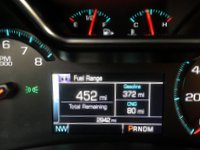
friendly GM representative to handle emergencies, directions and general assistance to make your driving experience safer and more enjoyable. This is one area where GM has been the industry leader and the program is well worth renewing after the introductory service plan expires.
Driving Impressions: Exterior
The look of the 2016 Impala is contemporary and attractive with a low stance and sculpted sides that suggests a vehicle in motion. Up front there are low-profile projector beam headlamps that sweep around the corners of a wide grille. Out back the short deck lid is framed by LED tail lamps and finished off by dual chrome exhaust tips.
Safety
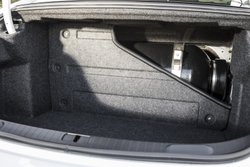
None of this comfort and styling is worth a thing if the car isn’t safe to drive. The 2016 Impala comes with 10 airbags, ABS with four-wheel disc brakes and electronic brake force distribution, hill start assist, forward collision and rear cross-traffic alerts, lane departure, side blind zone warning with lane change alert, electronic stability control and all-speed traction control.
In crash testing by the National Highway Traffic Safety Administration (NHTSA), the 2015 Impala (which is identical to the 2016 Impala reviewed here) received five stars for overall crash protection while the Insurance Institute for Highway Safety (IIHS) awarded the Impala its top rating of “Good.”
The Fueling Process
The Impala Bi-Fuel will be sold and serviced by nearly all of the 3,200 Chevrolet dealers in the United States and Canada, and is available for commercial, fleet and consumers. Your Chevrolet dealer will provide a list of local CNG stations but you will be best served by going to websites such as these http://www.afdc.energy.gov/locator/stations/ and http://cleanenergyfuels.com/ or downloading this app http://www.cngnow.com/app/Pages/information.aspx for iPhone or Android. After logging-on you simply enter a zip code and local stations appear on a map.
Once at the station, which will almost always be a 24/7 unmanned operation, you will swipe a major credit card and then, if it is your first time fueling, watch a short instructional video on the
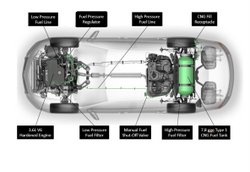
pump. The video will give you a three-number code and then explains how to attach the hose end to the fitting on the car and the sequence to start fueling. It is a very simple process with a full tank taking only minutes to fill. After doing it once, you will be a seasoned pro.
A note about CNG fueling stations. Many of them are located in an industrial setting and will not be freeway-close. They can be buried among storage yards and transportation centers where you will be pulling-up alongside city buses and trash trucks. Until more consumer-oriented CNG vehicles are offered by manufacturers, the fueling locations will be more for local commercial traffic and not road warriors traveling the freeways.
For those in California, the Impala Bi-Fuel automatically qualifies for the coveted HOV sticker which allows driving in the carpool lane with just the driver.
Pricing and Warranties
The 2016 Chevrolet Impala LT Bi-Fuel has a MSRP of $40,510 with Clean Fleet Report’s coming in at $41,800. Prices do not include the $825 Destination Charge.
The 2016 Impala LT Bi-Fuel warranties include:
- Bumper-to-Bumper – Three-year/36,000-mile
- Powertrain – Five-year/100,000-mile
- Roadside Assistance – Two-year/25,000-mile
- Factory Scheduled Service – Two-year/24,000-mile
- Rust-through Perforation – Six-year/100,000-mile
Observations: 2016 Chevrolet Impala LT Bi-fuel
The 2016 Chevrolet Impala competes in the full-size class against such cars as the Chrysler 300C, Ford Taurus, Toyota Avalon, Dodge Charger, Hyundai Azera and the Kia Cadenza. All are known for spacious interiors, the ability to carry five adults and having large trunks. At least one of them even come as a 40-mpg hybrid. But only Chevrolet offers a full-size sedan with a CNG option.
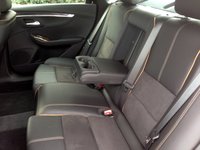
Your driving style is what will determine if the Impala Bi-fuel makes sense over the Impala with the four- or six-cylinder gas-only engines, as they will cost anywhere from $5,000 to $10,000 less. A big factor is the cost of CNG, which currently is 30-40 percent less than unleaded gasoline, making your cost per mile driven very low. If you drive a lot of CNG miles, then the numbers might work in your favor.
So where do you fit in as a future Impala Bi-Fuel owner? If your lifestyle requires a large sedan to transport adults in style and comfort, as opposed to a SUV, CUV or even one of the many midsize cars that almost equal the full-size class cars in interior space, then the 2016 Chevrolet Impala Bi-Fuel just might be sitting in your garage real soon.
Whatever you end up buying, enjoy your new car and as always, Happy Driving!
Related Stories You Might Enjoy:
Road Test: 2013 Honda Civic Natural Gas
Natural Gas Vehicles: A Viable Solution or Just Another Pipe Dream?
America’s Top 10 Cleanest Energy & Dirtiest Energy States
Road Test: Toyota Avalon Hybrid
Disclosure:
Clean Fleet Report is loaned free test vehicles from automakers to evaluate, typically for a week at a time. Our road tests are based on this one-week drive of a new vehicle, which does not address issues such as long-term reliability or total cost of ownership. In addition we are often invited to manufacturer events highlighting new vehicles or technology, during which we may be offered free transportation, lodging or meals. We do our best to present our unvarnished evaluations of vehicles and news irrespective of these inducements. Our focus is on vehicles that offer the best fuel economy in their class or are among the top mpg vehicles on the market. In addition, we aim to offer reviews and news on advanced technology and the alternative fuel vehicle market. We welcome any feedback from vehicle owners and are dedicated to providing a forum for alternative viewpoints. Please let us know your views at publisher@cleanfleetreport.com.

3 thoughts on “Road Test: 2016 Chevrolet Impala Bi-Fuel”